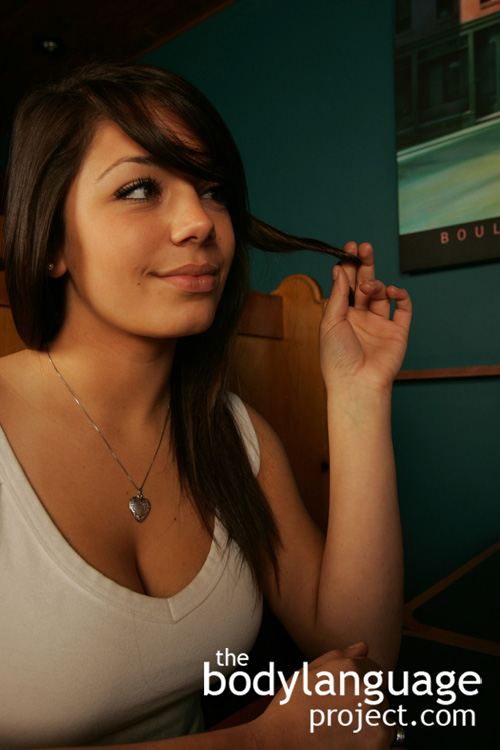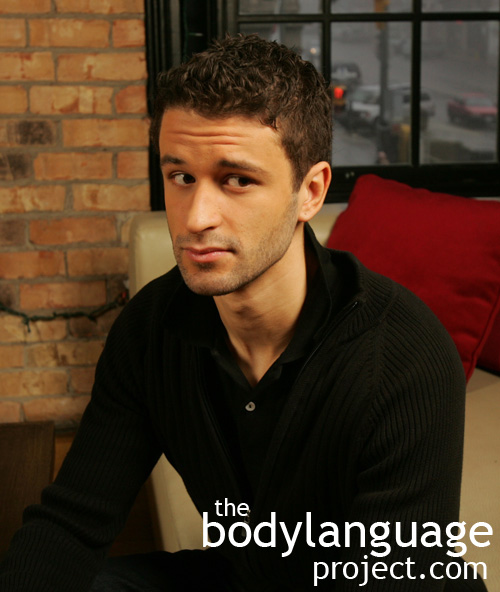Body Language of Lip Biting or Biting The Lip
 Cue: Lip Biting or Biting The Lip
Cue: Lip Biting or Biting The Lip
Synonym(s): Biting The Lip.
Description: Lightly biting the top or bottom lip with the teeth suddenly and in response to a particular stimuli or habitually and chronically.
In One Sentence: Lip biting is a sign of self restraint.
How To Use it: Women in dating can use the signal to show men that they are holding back “negative” or rather, naughty, sexually thoughts. When done properly with eye contact the signal is unmistakable. To send an even more powerful message, women should cast their eyes to the rest of the man’s body as this signals a desire for more than just friendship.
You might use lip biting in regular context to signal that you are holding back your tongue. This shows nonverbal disagreement without the risk of having to actually speak out.
Avoid chronic lip biting and chewing as this will tell others that you are self harming due to insecurity or anxiety.
Context: General.
Verbal Translation: “I’m biting my lip to hold myself back because I feel that if I stop biting, my lips might be free to say something I will regret.”
Variant: As the lip bite indicates that thoughts are being held back, a woman may use it in a dating context to signal that she is holding back naughty sexual thoughts. It is particularly salient when combined with eye contact or eyes dropping to his torso, genitals, or rump. See Lip Chewing or Chewing The Lips.
Cue In Action: She was biting her lip when her boyfriend bought her some really nice flowers, but ones of which she had previously experienced an allergic reaction.
Meaning and/or Motivation: Biting the mouth indicates hidden insecurity, anxiety, embarrassment, vulnerability and a lack of self confidence. It’s main cause, however, is that an idea is being held back – “by the skin of their teeth.” It’s where the saying goes “biting one’s lip” when voicing their opinion is what someone truly desires.
However, when someone bites their lip, they feel that their idea will not be well received or they don’t feel confident enough to stand up to challenges that might raise. Other times a person bites their lip because they are carrying a negative thought they don’t want to share.
When lip biting is done chronically, it can signal persistent underlying negative feelings. In this case, lip biting is in effort to calm and pacify through energy displacement and by offering them a source of control over their pain. It is a milder version of self cutting where high anxiety individuals will use knives to scare themselves because they feel their internal world is beyond their control.
Biting the lip has also been commonly associated with female sexual seduction where the lip is bitten while observing an attractive man. The roots are similar to what is mentioned above, that is, a restraint mechanism, where the woman holds herself back from acting on her sexual impulses.
Cue Cluster: Alongside lip biting expect to see eyes averted, head down, body turned away or loose trying to blend in, hands in the pockets or hidden under a table, neck scratching or holding the back of the neck in restraint.
Body Language Category: Aggressive body language, Courtship display, Clenching and gripping, Indicators of sexual interest (IOsI), Masked emotions, Micromessaging, Nervous body language, Pacifying body language, Stressful body language, Worry body language.
Resources:
Breau, Lynn M. ; Camfield, Carol S. ; Symons, Frank J. ; Bodfish, James W. ; MacKay, Alison ; Finley, G.Allen ; McGrath, Patrick J. Relation between pain and self-injurious behavior in nonverbal children with severe cognitive impairments. The Journal of Pediatrics. 2003 142(5): 498-503.
Croyle, Kristin L. ; Waltz, Jennifer. Subclinical Self-Harm: Range of Behaviors, Extent, and Associated Characteristics. American Journal of Orthopsychiatry. 2007. 77(2): 332-342.
Colville, G A; Mok, Q. Psychological management of two cases of self injury on the paediatric intensive care unit. Archives of Disease in Childhood. 2003. 88(4): 335.
Feteih RM: Signs and Symptoms of Temporomandibular Disorders and Oral Parafunctions in Urban Saudi Arabian Adolescents: A Research Report. Head Face Med. 2006. 2: 25.
Ghanizadeh, Ahmad and Hajar Shekoohi. Prevalence of Nail Biting and its Association With Mental Health in a Community Sample of Children. BMC Research Notes. 4 (Apr. 11, 2011): p116. DOI: http://dx.doi.org/10.1186/1756-0500-4-116.
http://bodylanguageproject.com/articles/body-language-nail-biting/
Gavish A, Halachmi M, Winocur E, Gazit E: Oral Habits and Their Association With Signs and Symptoms of Temporomandibular Disorders in Adolescent Girls. Journal of Oral Rehabilation. 2000, 27(1): 22-32.
Ghanizadeh A: Association of Nail Biting and Psychiatric Disorders in Children and Their Parents in a Psychiatrically Referred Sample of Children. Child Adolescents
Psychiatry Mental Health. 2008. 2(1):13.
Ghanizadeh, Ahmad. Association of nail biting and psychiatric disorders in children and their parents in a psychiatrically referred sample of children.(Research)(Clinical report). Child and Adolescent Psychiatry and Mental Health. 2008. 2(13): 13.
Christenson, Gary A. ; Mackenzie, Thomas B. ; Mitchell, James E. Characteristics of 60 adult chronic hair pullers. American Journal of Psychiatry. 1991. 148(3): 365(6).
Garnefski N 2004) Cognitive emotion regulation strategies and depressive symptoms: differences between males and female. Personal Indiv Diff 36: 267–76.
Harriss, Louise ; Hawton, Keith. Deliberate self-harm in rural and urban regions: A comparative study of prevalence and patient characteristics. Social Science & Medicine. 2011. 73(2): 274-281.
Huflejt-Łukasik M, Czarnota-Bojarska J (2006) Short Communication: Selffocused attention and self-monitoring influence on health and coping with stress. Stress Health 22: 153–59.
Jaquier, Véronique ; Hellmuth, Julianne C. ; Sullivan, Tami P.. Posttraumatic stress and depression symptoms as correlates of deliberate self-harm among community women experiencing intimate partnerviolence. Psychiatry Research. 2013. 206(1): 37-42.
Jacobson, Colleenm. ; Muehlenkamp, Jenniferj. ; Miller, Alecl. ; Turner, J. Blake. Psychiatric Impairment Among Adolescents Engaging in Different Types of Deliberate Self-Harm. Journal of Clinical Child & Adolescent Psychology. 2008. 37(2): 363-375.
Katza, Carmit; Irit Hershkowitz; Lindsay C. Malloya; Michael E. Lamba; Armita Atabakia and Sabine Spindlera. Non-Verbal Behavior of Children Who Disclose or do not Disclose Child Abuse in Investigative Interviews. Child Abuse & Neglect. 2012. 36: 12-20.
http://bodylanguageproject.com/articles/reading-nonverbal-behaviour-child-abuse-cases-encourage-children-divulge-information-truth-telling
Kravitz, Harvey. Lip biting in infancy. The Journal of Pediatrics. 1964. 65(1): 136-138.
Laye – Gindhu, Aviva ; Schonert – Reichl, Kimberly A.. Nonsuicidal Self-Harm among Community Adolescents: Understanding the “Whats” and “Whys” of Self-Harm. Journal of Youth and Adolescence. 2005. 34(5): 447-457.
Lyon, Lionel Sasson. A behavioral treatment of compulsive lip-biting. Journal of Behavior Therapy and Experimental Psychiatry. 1983. 14(3): 275-276.
Mohiyeddini, C., Bauer, S., & Semple, S. (2013a). Displacement behaviour is associated with reduced stress levels among men but not women. PLoS One, 8, e56355.
Mohiyeddini, C., Bauer, S., & Semple, S. (2013b). Public self-consciousness moderates the link between displacement behaviour and experience of stress in women. Stress, 16, 384–392.
Mohiyeddini, C., & Semple, S. (2013). Displacement behaviour regulates the experience of stress in men. Stress, 16, 163–171.
Moore, Monicam. Human Nonverbal Courtship Behavior—A Brief Historical Review. Journal of Sex Research. 2010 47(2-3): 171-180.
Moore, Monica. Courtship Signaling and Adolescents: Girls Just Wanna Have Fun. Journal of Sex Research. 1995. 32(4): 319-328.
http://bodylanguageproject.com/articles/girls-just-want-to-have-fun-the-origins-of-courtship-cues-in-girls-and-women/
Moore, Monica. M. Nonverbal Courtship Patterns in Women: Context and consequences. Ethology and Sociobiology. 1985. 6:237- 247.
Moore, M. M. Courtship Communication and Perception. Perceptual and Motor Skills. 2002. 94(1): 97-105. doi:10.2466/PMS.94.1.97-105.
Moore, M. M. and D. L. Butler. 1989. Predictive aspects of nonverbal courtship behavior in women. Semiotica 76(3/4): 205-215.
Moore, M. M. 2001. Flirting. In C. G. Waugh (Ed.) Let’s talk: A cognitive skills approach to interpersonal communication. Newark, Kendall-Hunt.
Nolen-Hoeksema S, Aldao A (2011) Gender and age differences in emotion regulation strategies and their relationship to depressive symptoms. Personal Indiv Diff 51: 704–8.
Nock, Matthew K. Actions speak louder than words: An elaborated theoretical model of the social functions of self-injury and other harmful behaviors. Applied and Preventive Psychology. 2008. 12(4): 159-168.
Navarro, Joe. 2008. What Every BODY is Saying: An Ex-FBI Agent’s Guide to Speed-Reading People. William Morrow Paperbacks.
Pelc AW, Jaworek AK: Interdisciplinary Approach to Onychophagia. Przegl Lek. 2003. 60(11): 737-739.
Ross, Shana ; Heath, Nancy. A Study of the Frequency of Self-Mutilation in a Community Sample of Adolescents. Journal of Youth and Adolescence. 2002. 31(1):.67-77.
Seekles, Wike ; van Straten, Annemieke ; Beekman, Aartjan ; van Marwijk, Harm ; Cuijpers, Pim. Effectiveness of guided self-help for depression and anxiety disorders in primary care: A pragmatic randomized controlled trial. Psychiatry Research. 2011. 187(1): 113-120.
Straker, Gillian. Signing with a Scar: Understanding Self-Harm. Psychoanalytic Dialogues. 2006. 16(1): 93-112
Sturman, Edward D. Invluntary Subordination and Its Relation to Personality, Mood,
and Submissive Behavior. Psychological Assessment. 2011. 23(1): 262-276 DOI: 10.1037/a0021499
http://bodylanguageproject.com/articles/nonverbal-submission-men-women-depression-critical-examination-use-disuse-submission/
Tanaka OM, Vitral RW, Tanaka GY, Guerrero AP, Camargo ES: Nailbiting, or Onychophagia: A Special Habit. American Journal of Orthod Dentofacial Orthop. 2008. 134(2): 305-308.
Tureck, Kim ; Matson, Johnny L. ; Beighley, Jennifer S. An investigation of self-injurious behaviors in adults with severe intellectual disabilities. Research in Developmental Disabilities. 2013. 34(9): 2469-2474.
Tamres L, Janicki D, Helgeson VS (2002) Sex differences in coping behaviour: a
meta-analytic review. Personal Soc Psychol Rev 6: 2–30.
Troisi A (2002) Displacement activities as a behavioural measure of stress in nonhuman primates and human subjects. Stress 5: 47–54.
Troisi A (1999) Ethological research in clinical psychiatry: the study of nonverbal
behaviour during interviews. Neurosci Biobehav Rev 23: 905–913.
Troisi A, Moles A (1999) Gender differences in depression: an ethological study
of nonverbal behaviour during interviews. J Psychiatr Res 33: 243–250.
Tamres L, Janicki D, Helgeson VS (2002) Sex differences in coping behaviour: a
meta-analytic review. Personal Soc Psychol Rev 6: 2–30.
von Hippel W, von Hippel C, Conway L, Preacher KJ, Schooler JW, et al. (2005) Coping with stereotype threat: denial as an impression management strategy. J Personal Soc Psychol 89: 22–35.





